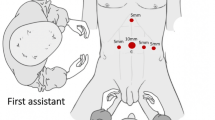Abstract
Background: The antireflux capacity of various gastric fundoplications combines the creation of a valve (flapper or nipple) with recreation of a sharp cardioesophageal angle. Experimental comparison of valve competency and appropriate valve geometry is incomplete despite wide application of these techniques. Our primary aim was to compare the competency of several antireflux valves in explanted cadaver stomachs. Our secondary aim was to understand better the geometry of the gastric fundus in empty and full stomachs.
Methods: Stomachs with 6–8 cm of distal esophagus were harvested from 18 fresh cadavers. With the stomach empty, the greater and lesser curvature length and the transverse dimensions of the anterior and posterior surface of the stomach in the fundus, body, and antrum were measured. The pylorus was tied off over a catheter; the stomachs were inflated with water; and reflux occurred. Intragastric pressure was measured during inflation with a needle inserted in the side of the stomach. A clamp was then placed on the esophagus, and the stomach was inflated to a pressure of 10 mmHg. Gastric measurements were recalculated in the distended stomach. The stomachs were deflated, the clamp removed, and a 2-cm Nissen fundoplication as well as 270° and 180° posterior fundoplications were performed over a 60 Fr dilator. The stomachs were reinflated while the pressure was transduced. The inflation was stopped when reflux occurred or when the fundoplication disrupted.
Results: The stomachs expanded symmetrically when filled with water except for the fundus in which the anterior gastric wall lengthened by more than 100% and the posterior gastric wall lengthened by about 50%. In the untreated stomachs, reflux occurred at a pressure of 3.0 ± 1.0 mmHg. After fundoplication, reflux never occurred, but the sutures pulled out of the stomach or esophagus at 28.6 ± 16.8 mmHg. Posterior fundoplications refluxed water in several stomachs.
Conclusions: When filled, the anterior fundus expands to a greater degree than the posterior fundus, offering more tissue for creation of floppy fundoplication. The ``floppy'' Nissen fundoplication is completely competent, suffering a degradation before allowing reflux. The posterior partial fundoplication is unpredictable in its competency.
Similar content being viewed by others
Author information
Authors and Affiliations
Additional information
Received: 3 April 1997/Accepted: 22 May 1998
Rights and permissions
About this article
Cite this article
Richardson, W., Hunter, J. The “floppy” Nissen fundoplication is a completely competent antireflux valve. Surg Endosc 13, 142–145 (1999). https://doi.org/10.1007/s004649900924
Published:
Issue Date:
DOI: https://doi.org/10.1007/s004649900924



